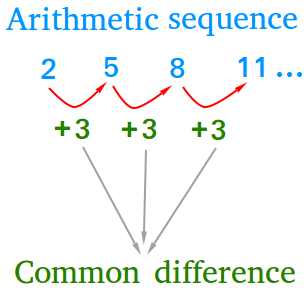Common difference of an arithmetic sequence
The common difference of an arithmetic sequence is the fixed number that is added to each number in the sequence, except the first number or starting number. The figure below shows the common ratio for the arithmetic sequence 2, 6, 18, 54, ...

Notice that 5 - 2 = 3, 8 - 5 = 3, and 11 - 8 = 3. The name common difference came from the fact that the difference between consecutive numbers is constant.
Other examples showing what the common difference of an arithmetic sequence is
a.
Arithmetic sequence: 7, 11, 15, 19, ...
The common difference is 4
b.
Arithmetic sequence: 5, 11, 17, 23, ...
The common difference is 6
c.
Arithmetic sequence: 8, 8 + d, 8 + 2d, 8 + 3d, ...
The common difference is d for the following reason:
8 + d - 8 = d
8 + 2d - (8 + d) = 8 + 2d - 8 - d = d
8 + 3d - (8 + 2d) = 8 + 3d - 8 - 2d = d
There is something interesting about c.!
The second number is 8 + d = 8 + 1d
The third number is 8 + 2d
The fourth number is 8 + 3d
What can we conclude about the nth number?
Notice that the number in blue is always one less than the term number shown in red. For example, for 8 + 3d, the number in blue is 3 for the 4th number.
We can also say that for 8 + (n - 1)d, the number in blue is n - 1 for the nth.
Therefore, nth term = 8 + (n - 1)d for the arithmetic sequence 8, 8 + d, 8 + 2d, 8 + 3d, ...